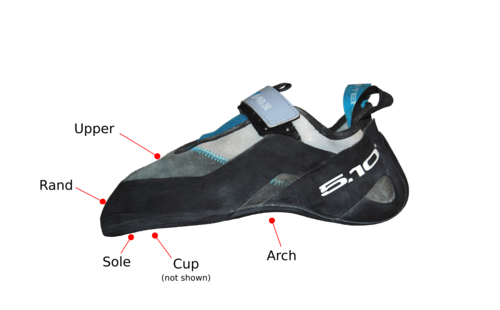Climbing Shoe Anatomy

Last – when a climbing shoe is manufactured, it is built around a foot-shaped form. This form is known as a last and has a large impact on the fit and style of the shoe. We use custom made lasts during our resoling process.
Upper – this is the leather or textile material that holds the whole shoe together. We do not alter this section of the shoe as it affects the fit.
Rand – the thin rubber layer that covers the tip of the shoe and wraps underneath, between the sole and the upper. This rubber will become thin with wear and eventually a hole can form.
Cup (sole concavity) – this is not present on all shoes. Some aggressively down-turned shoes also have a concave shape to the sole just underneath your toes that can help hook into pockets or small toe holds. This is particularly helpful on overhanging terrain, but can reduce contact area, and therefore friction, during smearing.
Sole – the 3 to 6 mm layer of rubber on the bottom of the shoe. The sole of a new or freshly resoled shoe will have a sharp edge that allows precise edging on small foot holds. As the sole wears, this edge becomes rounded and provides less contact area, and therefore less friction, on small sharp features.
Arch – the arch of the shoe contributes to how aggressive the shoe will be and is built in during manufacture. Aggressive shoes will be built around an aggressive last. This is particularly important as the arch can be affected during a resole if the appropriate last is not used.
